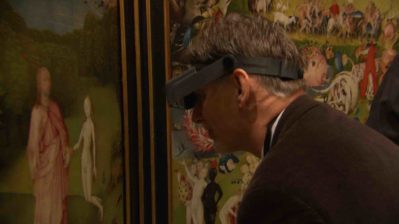INTERVIEW: New documentary enters the world of Hieronymus Bosch

The paintings of Hieronymus Bosch have entranced art appreciators for hundreds of years. These large-scale depictions of religious scenes, some of them quite violent and disturbing, offer multiple portraits of humanity’s run-in with God’s power. His most famous painting is “The Garden of Earthly Delights,” on display at the Prado in Madrid. The three-panel creation is an exquisite and scary look into biblical themes.
This year marks the 500th anniversary of Bosch’s death, and there have been many international projects to recognize the influential master and his works. The latest is an engaging documentary from Pieter van Huystee, a Danish film producer who traveled with a team of art researchers as they studied each of Bosch’s more than two dozen surviving paintings. Their goal was to archive the oeuvre and plan for an exhibition at the Noordbrabants Museum in Bosch’s hometown, Den Bosch, in the Netherlands.
Hieronymus Bosch: Touched by the Devil, which is currently playing New York’s Film Forum, follows these researchers as they view and debate Bosch’s influence; the film also shows the inner-workings of the art world and the difficulty in putting together an exhibition with loaned paintings.
For Huystee, Hieronymus Bosch: Touched by the Devil is his first documentary as director.
“Normally I’m a film producer for documentaries,” Huystee said recently in a phone interview. “So actually my habit is to read everyday the newspapers for some hours, and I saw that they were doing this research and planned to do this. It was five years ago that they came up with this plan, and I [met] those people … to do research for a new subject for one of my directors. And very quickly I found myself every week and every day in the library to know more about the work of Hieronymus Bosch.”
The subject matter proved so interesting that Huystee decided to keep the project for himself. As he delved deeper into Bosch’s world it became clear that there are many competing theories about the artist. For one, did Bosch paint these masterpieces himself or have a team of artists in a workshop environment? Can research on the wood attached to the paintings better date the pieces? Are there Bosch paintings that have gone unnoticed in the world?
“I said, ‘Well, this is an opportunity to see all those paintings,’” Huystee said. “I love art. I’m passionate about art. I’m not an expert on art. I don’t study art … but I thought, well, having the opportunity to visit the museums how wonderful life can be.”
Most of the researchers were happy with Huystee following them around. It was a difficult shooting process because museums are quiet places, and these masterpieces are tightly guarded by the institutions that own them. It was up to Huystee to be a fly on the wall, but he needed as much access as possible.
“I have a good reputation of producing documentaries in an honest way,” he said. “We are a very small team, but then of course everybody said, ‘You will never manage to get into the Prado … or the Louvre or the National Gallery.’ But I said, ‘I’m part of this research team.’ So I made myself very small, very modest.”
Because people tend to whisper in museums, Huystee needed to place microphones his subjects in the morning in order to catch their hushed talking and debating in front of the works of art.
Still, some of the museums, in particular the Prado, were only open and sharing to a point. For example, watching the film, it doesn’t seem like there’s even the slightest chance “The Garden of Earthly Delights” will be loaned to the archivists. Still, the Prado allowed Huystee to film within its storied halls and document close-ups of the masterpiece, so all was not lost.
In the film, when the archivists begin their meticulous work of documenting, studying and theorizing, the art appreciation is abundant. “It’s like witnessing a police investigation,” the director said. “If you visit a museum in Venice on a Tuesday morning, you don’t think this is work. You think this is fun.”
He added: “It was important for me that the viewer had always the feeling that you’re there next to the painting. … If somebody came to me after the screenings and said, I’ve seen ‘The Garden of Earthly Delights’ many times in real, but he says, ‘It always remains on the distance because it is so detailed. And you don’t come close, and you don’t get emotionally attached to the painting if you see it in real.’ So in the film, in the documentary, I have the opportunity to be very close, sometimes to a square centimeter.”
In many ways, Huystee documents the paintings from the vantage point of Bosch. The director is as meticulous a craftsman, working from close-ups and always focused on the details. “The devil is in the details,” he said. “I hope people can reflect on what he was painting. He was not telling us something. You’re telling yourself something by looking at the paintings.”
By John Soltes / Publisher / John@HollywoodSoapbox.com
Hieronymus Bosch: Touched by the Devil is currently playing the Film Forum in New York City. Click here for more information.

